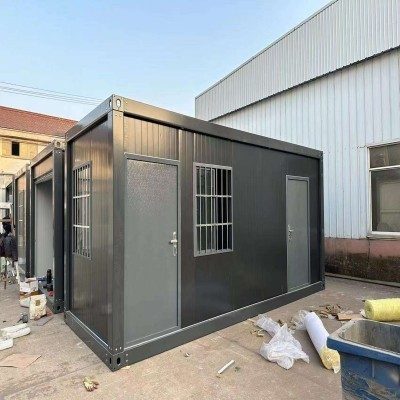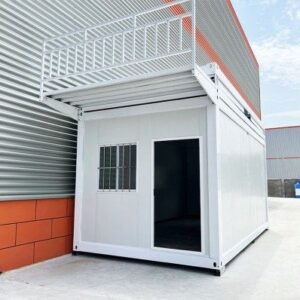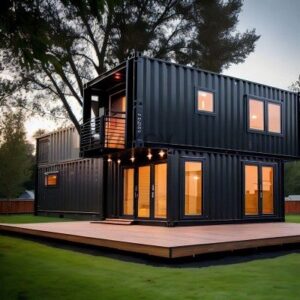If you’re wondering how much does a container house cost to build, you’re not alone. Building a container home is an exciting way to create affordable, modern living spaces—but understanding the full cost upfront is crucial to avoid surprises. From purchasing containers to customization, permits, and utilities, the price varies widely depending on your design and location. In this guide, you’ll get a clear breakdown of all the key expenses involved, plus smart tips to keep your build within budget without sacrificing quality. Let’s cut through the noise and give you the real numbers you need to plan your container home project confidently!
Detailed Cost Breakdown of Building a Container House
When it comes to understanding how much does a container house cost to build, breaking down the expenses helps you plan better. Costs vary widely depending on size, location, and design, but here’s a solid overview of what to expect.
Average Cost Per Square Foot and Per Container
On average, building a container home costs around $150 to $250 per square foot in the U.S. This depends on how much customization you want and where you build. For a standard 40-foot container (about 320 sq ft), expect:
- Basic container purchase: $2,000 to $5,000 (used or new)
- Modification and conversion: $20,000 to $50,000 depending on interior work and structural changes
Some prefabricated or simpler models might come in cheaper, but extensive designs and custom builds push prices higher.
Container Purchase Price vs Modification Costs
- Containers themselves are just the beginning. Prices depend on size (20ft or 40ft) and condition.
- Modification costs—cutting openings, welding, reinforcing, and framing—usually run 4 to 10 times the container purchase price.
This means buying a $3,000 container might cost you $15,000 or more once fully modified.
Site Work and Foundation Expenses
Before placing containers, site prep and foundation are essential:
- Foundation cost varies widely from $5,000 to $20,000 depending on soil, terrain, and foundation type (concrete slab, piers, or footers).
- Site clearing and grading can add extra charges, especially in rural or uneven terrain.
Interior Finishing Flooring Walls Windows Doors
Inside finishing will shape much of your budget:
- Flooring options like laminate, tile, or hardwood range from $3 to $10 per square foot.
- Insulated walls with drywall or paneling might cost $10,000+ for an average container home.
- Quality windows and doors, critical for natural light and ventilation, add $5,000 to $15,000+.
Electrical Plumbing HVAC Systems
A container home requires full utility setup:
- Electrical installation including wiring and fixtures runs between $8,000 and $15,000.
- Plumbing—kitchen, bathrooms, water lines—often costs $7,000 to $12,000, depending on complexity.
- HVAC systems like mini-split heat pumps or portable units add $3,000 to $8,000 depending on climate.
Additional Amenities Solar Panels Decks Smart Home Tech
Adding extras increases costs but improves living quality:
- Solar panel systems to make your container home more energy-efficient start around $10,000+.
- Custom decks or patios typically add $5,000 to $15,000, depending on size and materials.
- Smart home features like automated lighting, security, and thermostats add between $1,000 and $5,000.
Contingency and Unexpected Expenses
Container house building often runs into surprise costs like:
- Unforeseen structural reinforcements
- Permit delays or additional fees
- Weather-related site work complications
Experts recommend setting aside 10% to 15% of your total budget as a contingency fund to cover these unexpected expenses.

What Is a Container House Definition and Types
A container house is a dwelling constructed using shipping containers as the basic structural element. These containers, originally designed for transporting goods worldwide, have become a popular and sustainable option for innovative housing solutions across the United States.
There are several types of container homes to consider, depending on your needs and budget:
- Single Unit Container HomesThese use one standard shipping container (typically 20 or 40 feet long) converted into a compact living space. They are ideal for small, affordable homes or accessory dwelling units.
- Multi-Unit Container HomesThese combine two or more containers, either stacked or joined side-by-side, creating more spacious layouts suitable for families or multi-room residences.
- Modified Container HomesThese containers are structurally altered to include larger openings for windows and doors, with significant interior redesign. Modifications might include cutting, welding, and reinforcing the steel structure to fit custom purposes.
- Custom Container HomesFully tailored to the homeowner’s preferences, these homes often mix container modules with traditional building materials. Custom designs can include high-end finishes, smart home tech, solar energy setups, and luxury amenities.
Common Uses and Benefits of Container Houses
Many people choose container homes for a variety of practical reasons. Container houses serve not only as permanent residences but also vacation cabins, guest houses, offices, or pop-up retail spaces.
The benefits of container homes include:
- Affordability — Often lower construction costs compared to traditional homes.
- Speed of Construction — Containers can be modified off-site and assembled quickly onsite.
- Durability — Made from robust steel, containers withstand harsh weather conditions and natural disasters.
- Eco-Friendly — Repurposing steel containers reduces waste and supports sustainable building practices.
- Mobility and Flexibility — Container homes can be relocated or expanded with relative ease.
- Unique Design Opportunities — Their modular nature offers refreshing architectural aesthetics and efficient space use.
Key Factors That Influence Container House Building Costs
When figuring out how much does a container house cost to build, several key factors play a role in the final price. Understanding these will help you budget smartly and avoid surprises.
Size and Number of Containers Used
The size of your container home and how many shipping containers you use have the biggest impact on overall cost. A single 20ft container is cheaper upfront, but multi-unit setups with 40ft or more containers increase both material and modification costs.
Customization and Design Complexity
Simple, boxy designs cost less. The more custom your container home is—adding windows, cutting doors, connecting units, or installing specialized interiors—the higher your container home modification costs will be.
Location and Local Construction Costs
Building costs vary widely across the U.S. Labor rates, material availability, and local economies affect prices. Urban areas typically have higher labor costs and permit fees than rural locations.
Foundation and Site Preparation
Container homes still need solid foundations. Site grading, concrete slabs, piers, or crawl spaces add to your container house foundation cost. Tough or uneven land can increase site prep expenses.
Insulation and Weatherproofing Needs
Since containers are steel, insulation is a must to handle heat, cold, and humidity. The cost to insulate a container home depends on your climate and chosen materials, impacting comfort and long-term energy bills.
Utilities and Plumbing Installation
Adding electricity, plumbing, and HVAC can be complex depending on your site’s existing hookups or if you’re off-grid. These systems contribute heavily to the container house installation cost.
Permits Inspections and Legal Fees
Permits vary by state and city but can add several thousand dollars in fees. Failing to account for required inspections or zoning approvals can delay build times and add unexpected costs.
Labor Costs Versus DIY Potential
Labor costs depend on how much work you hire out. If you’re handy, doing portions yourself can save money but weigh that against the time and skills required. Hiring professionals ensures quality and compliance but adds to your expenses.
By keeping these factors in mind, you can better estimate the shipping container home price breakdown and plan your build efficiently.
Comparison Container Home Costs vs Traditional Home Construction
When weighing container home costs against traditional home construction, it’s key to look beyond just the initial price tag. Both options have different cost structures, maintenance demands, and long-term financial impacts.
Upfront Investment Differences
| Cost Aspect | Container Home | Traditional Home |
|---|---|---|
| Average cost per square foot | $100 – $200 | $150 – $300 |
| Construction time | 3 to 6 months | 6 to 12 months |
| Material costs | Lower (recycled containers) | Higher (lumber, concrete, etc.) |
| Labor costs | Can be lower with DIY options | Usually higher due to complexity |
| Permitting and inspections | Similar but can vary by location | Standard building codes apply |
- Container homes generally require less upfront investment per square foot because the basic structure—a steel shipping container—is already made.
- Traditional homes rely heavily on raw materials and site-built framing, raising costs.
- Time savings with container homes often translate to reduced labor expenses.
Maintenance Costs
- Container homes require regular inspections for rust and corrosion, especially in humid areas.
- Traditional homes have ongoing upkeep for roofs, siding, and foundations, which can be costly.
- Both home types benefit from proper maintenance but container homes might need specialized care due to steel construction.
Long-Term Savings and Energy Efficiency
- Container homes typically offer better energy efficiency when properly insulated and sealed, reducing heating and cooling bills.
- Steel shells hold up against extreme weather well, lowering future repair costs.
- Many container homes pair well with solar panels and smart home tech for further savings.
- Traditional homes can achieve energy efficiency but often require extra installation of insulation, double-pane windows, and HVAC upgrades.
Container houses tend to be more affordable upfront and can lead to lower energy costs over time, but they may need attention to weatherproofing and corrosion. Traditional homes involve bigger initial expenses but have a long track record of durable performance and variety in design and materials. Your budget, timeline, and lifestyle will ultimately decide which option fits best.
How to Save Money When Building a Container Home
Building a container house can get pricey, but there are smart ways to keep costs down without sacrificing quality or comfort. Here’s how you can save money on your container home project by focusing on key areas like sourcing, design, and labor.
Source Affordable Containers and Materials
- Buy used containers instead of new ones. Used shipping containers are often in good condition and much cheaper, especially if you buy locally.
- Look for regional suppliers to save on shipping costs. Transportation can add significant expenses to your container house installation cost.
- Repurpose materials where possible. For example, reclaimed wood, recycled insulation, and secondhand windows or doors can cut down modification costs significantly.
Prioritize Essential Modifications
- Focus on must-have modifications like insulation, ventilation, and structural reinforcements first. Cosmetic upgrades like luxury finishes or extensive custom walls can wait or be scaled back.
- Avoid over-customizing early on. Every cut or weld adds to the container home modification costs. Keep structural changes minimal to stick with your budget.
DIY Some Work vs Hiring Professionals
- Do-it-yourself where possible: Simple interior work like painting, flooring installation, and basic cabinetry can save thousands in labor costs.
- For complex work like electrical, plumbing, or structural welding, hire licensed professionals to avoid costly mistakes and delays.
- Consider a hybrid approach: handle small finishes yourself but outsource specialized tasks. This balances cost and quality.
Choose Simpler Designs to Reduce Costs
- Stick to basic shapes and layouts. Single-unit container homes or stacked units with minimal alterations cost less than elaborate multi-container custom designs.
- Avoid complex rooflines or foundation requirements. Simpler foundations lower your container house foundation cost significantly.
- Limit extra amenities like decks, solar panels, or smart home tech during initial construction; add them later if budget allows.
By keeping your container home design straightforward, sourcing wisely, and mixing DIY efforts with professional help, you can manage your project budget effectively while still creating a comfortable, stylish living space.
Real Life Examples of Container House Costs and Lessons Learned
Looking at real-life projects helps us understand how much a container house costs to build and what to expect. Here are two detailed examples—one budget-friendly and one luxury build—to give you a clear picture.
Example 1 Budget Friendly Container Home Build
Project overview:
- Single 20-foot container modified into a cozy tiny home
- Basic insulation and simple electrical/plumbing setup
- Minimal interior finishing with laminate floors and standard fixtures
Costs involved:
- Shipping container purchase: $2,000
- Modifications and insulation: $8,000
- Foundation and site prep: $3,000
- Utilities hookup (electric, water, septic): $5,000
- Labor (DIY with limited hired help): $4,000
- Permits and inspections: $1,000
Total estimated cost: $23,000 to $25,000
Lessons learned:
- DIY saves a ton on labor but requires time and skills
- Keeping design simple avoids expensive custom work
- Good planning on insulation helps avoid high heating/cooling costs later
Example 2 Luxury Customized Container Home Build
Project overview:
- Multiple 40-foot containers combined for a two-bedroom home
- High-end finishes: hardwood floors, custom cabinetry, large windows
- Solar panel system and smart home technology installed
- Advanced HVAC and plumbing systems
Costs involved:
- Containers purchase: $8,000
- Custom modifications and structural reinforcements: $40,000
- Foundation and site work: $15,000
- Interior finishes and appliances: $35,000
- Electrical, plumbing, HVAC: $20,000
- Solar and smart tech: $12,000
- Labor (professional contractors): $30,000
- Permits and fees: $3,000
Total estimated cost: $163,000 to $170,000
Lessons learned:
- Customization and luxury features significantly increase costs
- Hiring experienced contractors ensures quality but adds to labor budget
- Investing in energy efficiency and technology pays off in long-term savings
Both examples show how size, customization, location, and labor choices impact container house building expenses. Whether going for a minimalist and affordable container home or a luxurious custom build, understanding these cost drivers helps you plan better and avoid surprises.
Frequently Asked Questions About Container Home Costs
Can I Build a Container Home Myself
Yes, DIY container home building is possible and can save you money on labor. However, it requires some construction skills, time, and access to tools. If you’re comfortable handling tasks like welding, insulation, wiring, and plumbing, you can reduce costs significantly. Keep in mind:
- Some steps, like foundation work and permits, might still require professionals.
- Mistakes can lead to costly fixes, so be realistic about your skills.
- DIY works best for simpler designs and smaller container homes.
What Are Hidden Costs to Watch For
When budgeting, don’t overlook these often-hidden expenses in container house building:
- Permits and inspections: These can add several thousand dollars depending on your location.
- Foundation and site prep: Soil work, leveling, and concrete pads are necessary and can surprise many builders.
- Insulation and ventilation needs: Proper insulation suitable for your local climate is crucial but can be pricey.
- Utilities connection: Running water, sewer, and electrical hookups can get costly depending on how far your site is from existing lines.
- Container modifications: Cutting, reinforcing, and weatherproofing containers usually cost more than just buying them.
- Unexpected repairs: Containers may have rust or damage requiring additional fixes.
Is Financing Available for Container Houses
Financing container homes can be trickier than traditional homes but it’s increasingly possible:
- Some lenders specialize in shipping container construction loans or modular home financing.
- Personal loans, construction loans, or FHA loans might be options if the container home meets local building codes.
- Having detailed plans, permits, and proof of property ownership improves financing chances.
- Self-builders may face stricter loan terms or higher interest rates.
How Long Does It Take to Build a Container Home
The time to build depends largely on size, complexity, and whether you’re doing a DIY or hiring pros:
- Basic single-container homes with minimal modifications can be done in 2 to 3 months.
- Larger or multi-container homes with custom features often take 6 months or more.
- Weather, permitting delays, and availability of materials also affect timelines.
- Professional builders typically finish faster due to experience and crew size.
Knowing these facts upfront helps set realistic expectations for budget and schedule when planning your container house build.
Why Choose Yichen for Your Container House Needs
When it comes to building a container house, Yichen stands out for expertise, quality, and cost efficiency. Here’s why choosing Yichen makes sense for your container home project:
Proven Expertise and Comprehensive Services
Yichen has years of hands-on experience in designing and building container homes tailored to U.S. customers’ needs. Whether you want a single-unit or a multi-unit custom container home, Yichen provides:
- Design consultation focusing on cost-effective layouts
- Assistance with permits and local code compliance
- Full-service container modification and fabrication
- Support for site preparation, foundation, and installation
This all-in-one approach simplifies your project and helps avoid costly mistakes common in container home construction.
Commitment to Quality and Transparency
Yichen prioritizes durable materials and high craftsmanship to ensure your container house stands the test of time and weather. They offer:
- Detailed, transparent cost breakdowns so you know exactly where your money goes
- Use of proven brands and eco-friendly insulation and finishes adapted to U.S. climates
- Regular updates throughout the build to keep you informed and in control
This level of openness builds trust and ensures your investment matches your expectations.
Cost and Design Optimization
One of the biggest concerns with container houses is controlling expenses without sacrificing comfort or style. Yichen excels in optimizing:
- Container home modification costs by choosing practical yet stylish design elements
- Efficient use of space to reduce the cost per square foot of container house
- Energy-saving features such as insulation, solar panels, and smart home tech that cut long-term bills
- Selecting the right container sizes and foundation types to cut unnecessary expenses
Their experts work with you to balance your budget and vision, delivering an affordable, customized container home that fits your lifestyle



